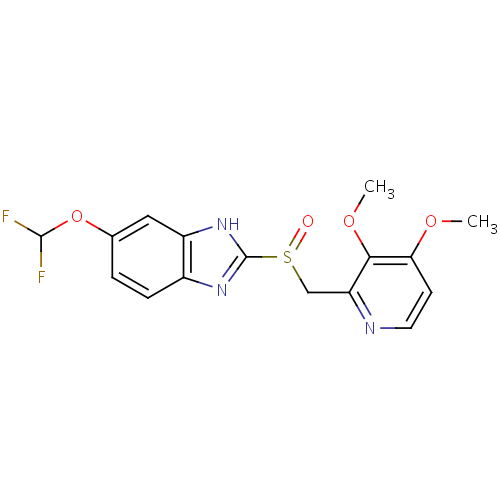药品详细
Pantoprazole(泮托拉唑)
化学结构式图

中文名
泮托拉唑
英文名
Pantoprazole
分子式
C16H15F2N3O4S
化学名
6-(difluoromethoxy)-2-{[(3,4-dimethoxypyridin-2-yl)methane]sulfinyl}-1H-1,3-benzodiazole
分子量
Average: 383.37
Monoisotopic: 383.075133083
Monoisotopic: 383.075133083
CAS号
102625-70-7
ATC分类
A02B 未知
药物类型
small molecule
阶段
approved
商品名
Astropan;Pantoloc;Pantopan;Pantor;Pantozol;Protium;Protonix;Protonix I.V.;Protonix IV;
同义名
Pantoprazol [INN-Spanish];Pantoprazole Na;Pantoprazole Sodium;Pantoprazolum [INN-Latin];Pantoprozole;
基本介绍
Pantoprazole is a proton pump inhibitor drug used for short-term treatment of erosion and ulceration of the esophagus caused by gastroesophageal reflux disease.
生产厂家
- Kudco ireland ltd
- Sun pharma global inc
- Teva pharmaceuticals usa inc
- Wyeth pharmaceuticals inc
封装厂家
- Advanced Pharmaceutical Services Inc.
- Amerisource Health Services Corp.
- Apotheca Inc.
- AQ Pharmaceuticals Inc.
- A-S Medication Solutions LLC
- Cardinal Health
- Coupler Enterprises Inc.
- Direct Pharmaceuticals Inc.
- DispenseXpress Inc.
- ESI Lederle
- Innoviant Pharmacy Inc.
- Kaiser Foundation Hospital
- Lake Erie Medical and Surgical Supply
- Murfreesboro Pharmaceutical Nursing Supply
- Nucare Pharmaceuticals Inc.
- Nycomed Inc.
- Patheon Inc.
- Physicians Total Care Inc.
- Prepackage Specialists
- Prepak Systems Inc.
- Ranbaxy Laboratories
- Rebel Distributors Corp.
- Redpharm Drug
- Resource Optimization and Innovation LLC
- Schwarz Pharma Inc.
- Southwood Pharmaceuticals
- Stat Rx Usa
- Sun Pharmaceutical Industries Ltd.
- Teva Pharmaceutical Industries Ltd.
- Vangard Labs Inc.
- Wasserburger Arzneimittelwerk GmbH
- Wyeth Pharmaceuticals
参考
| Synthesis Reference | Not Available |
| General Reference | Not Available |
剂型
规格
化合物类型
| Type | small molecule |
| Classes |
|
| Substructures |
|
适应症
gastric acid RELATED DISORDERS 中和胃酸;
药理
| Indication | Short-term (up to 16 weeks) treatment of erosive esophagitis. | ||||||
| Pharmacodynamics | Pantoprazole is a substituted benzimidazole indicated for the short-term treatment (up to 16 weeks) in the healing and symptomatic relief of erosive esophagitis. Pantoprazole is a proton pump inhibitor (PPI) that suppresses the final step in gastric acid production. | ||||||
| Mechanism of action | Pantoprazole is a proton pump inhibitor (PPI) that suppresses the final step in gastric acid production by forming a covalent bond to two sites of the (H+,K+ )- ATPase enzyme system at the secretory surface of the gastric parietal cell. This effect is dose- related and leads to inhibition of both basal and stimulated gastric acid secretion irrespective of the stimulus. | ||||||
| Absorption | Pantoprazole is well absorbed. It undergoes little first-pass metabolism resulting in an absolute bioavailability of approximately 77%. | ||||||
| Volume of distribution |
|
||||||
| Protein binding | 98% | ||||||
| Metabolism |
Pantoprazole is extensively metabolized in the liver through the cytochrome P450 (CYP) system. The main metabolic pathway is demethylation, by CYP2C19, with subsequent sulfation; other metabolic pathways include oxidation by CYP3A4. There is no evidence that any of the pantoprazole metabolites have significant pharmacologic activity.
|
||||||
| Route of elimination | After administration of a single intravenous dose of 14C-labeled pantoprazole to healthy, normal metabolizer subjects, approximately 71% of the dose was excreted in the urine with 18% excreted in the feces through biliary excretion. | ||||||
| Half life | 1 hour | ||||||
| Clearance |
|
||||||
| Toxicity | Single intravenous doses of pantoprazole at 378, 230, and 266 mg/kg (38, 46, and 177 times the recommended human dose based on body surface area) were lethal to mice, rats and dogs, respectively. The symptoms of toxicity included hypoactivity, ataxia, hunched sitting, limb-splay, lateral position, segregation, absence of ear reflex, and tremor. There is limited experience regarding cases of human overdosage, and treatment should be symptomatic and supportive. | ||||||
| Affected organisms |
|
||||||
| Pathways |
|
理化性质
| Properties | |||||||||||||||||||||||||||||||||||||||||||
|---|---|---|---|---|---|---|---|---|---|---|---|---|---|---|---|---|---|---|---|---|---|---|---|---|---|---|---|---|---|---|---|---|---|---|---|---|---|---|---|---|---|---|---|
| State | solid | ||||||||||||||||||||||||||||||||||||||||||
| Experimental Properties |
|
||||||||||||||||||||||||||||||||||||||||||
| Predicted Properties |
|
||||||||||||||||||||||||||||||||||||||||||
药物相互作用
| Drug | Interaction |
|---|---|
| Atazanavir | This gastric pH modifier decreases the levels/effects of atazanavir |
| Cefditoren | Proton pump inhibitors such as pantoprazole may decrease the serum concentration of cefditoren. If possible, avoid use of cefditoren with proton pump inhibitors (PPIs). Consider alternative methods to minimize/control acid reflux (eg, diet modification) or alternative antimicrobial therapy if use of PPIs can not be avoided. |
| Clopidogrel | Pantoprazole may decrease serum concentrations of the active metabolite(s) of clopidogrel. Due to the possible risk for impaired clopidogrel effectiveness with this combination, clinicians should carefully consider the need for concurrent pantoprazole therapy in patients receiving clopidogrel. Monitor response to clopidogrel closely when using clopidogrel with pantoprazole. Whether there are differences among individual proton pump inhibitors is unclear. Other acid-lowering therapies (e.g., H2-receptor antagonists, antacids, etc.) do not appear to share this interaction with clopidogrel. |
| Dabigatran etexilate | Proton pump inhibitors may decrease the bioavailability of dabigatran by 28% and increase inter-patient pharmacokinetic variability, especially in females. However, dose adjustment is not required. |
| Dabrafenib | Proton pump inhibitors may alter the solubility of dabrafenib and reduce its bioavailability. |
| Dasatinib | Pantoprazole may decrease the serum level of dasatinib. |
| Enoxacin | Pantoprazole may decrease the absorption of enoxacin. |
| Indinavir | Omeprazole decreases the absorption of indinavir |
| Itraconazole | The proton pump inhibitor, pantoprazole, may decrease the absorption of itraconazole. |
| Ketoconazole | The proton pump inhibitor, pantoprazole, may decrease the absorption of ketoconazole. |
| Rilpivirine | Proton-pump inhibitors increase gastric pH which causes a decrease in the exposure of rilpivirine thus reducing efficacy. |
| Topotecan | The BCRP/ABCG2 inhibitor, Pantaprazole, may increase the bioavailability and serum concentration of oral Topotecan. Monitor for change in the therapeutic and adverse effects of Topotecan if Pantaprazole is initiated, discontinued or dose changed. |
食物相互作用
- Take without regard to meals.
